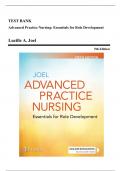Exam (elaborations)
Test Bank - Advanced Practice Nursing: Essentials for Role Development, 5th Edition (Joel, 2023), Chapter 1-30 | All Chapters
- Course
- Institution
- Book
Test Bank - Advanced Practice Nursing: Essentials for Role Development, 5th Edition (Joel, 2023), Chapter 1-30 | All Chapters
[Show more]



